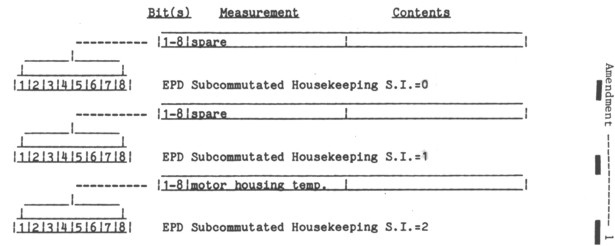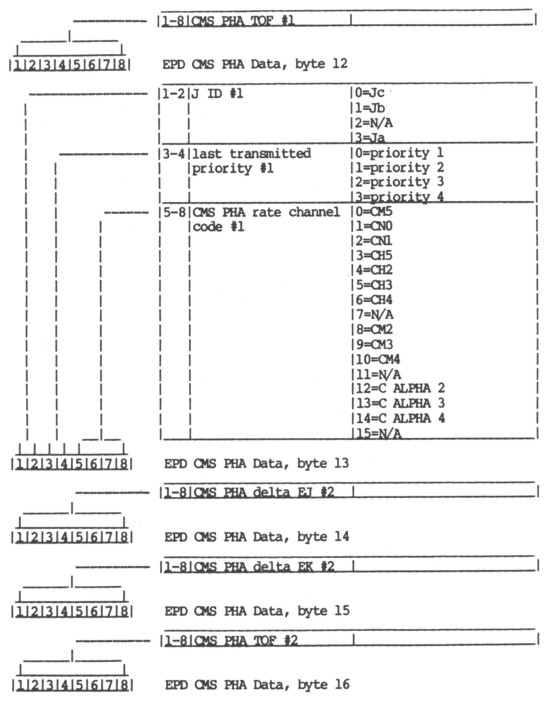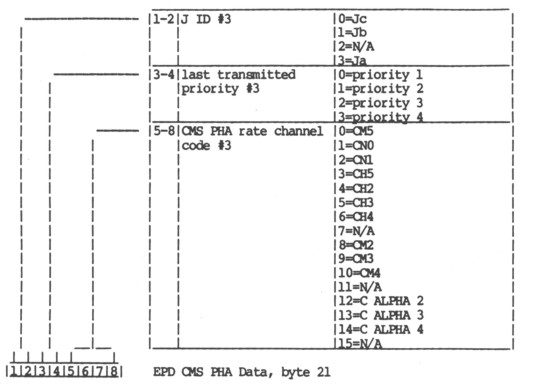The Galileo Energetic Particles Detector
Galileo EPD Handbook
Appendices
Appendix A. EDR File Structure (continued)
3. EPD Subsystem Telemetry (continued)
Source: GLL-3-280, Rev. B, Appendix A, March 15, 1985
CMS PHA/LEMMS PHA Data
The contents of the CMS PHA/LEMMS PHA Data section can be either CMS PHA data or LEMMS PHA data. The timing of when the data is CMS PHA or LEMMS PHA is shown in Table 3.
Table 3. SI vs. CMS PHA/LEMMS PHA section contents
| MOD 91 | Contents |
| 2 | LEMMS PHA data |
| 9 | LEMMS PHA data |
| 16 | LEMMS PHA data |
| 23 | LEMMS PHA data |
| 30 | LEMMS PHA data |
| 37 | LEMMS PHA data |
| 44 | LEMMS PHA data |
| 51 | LEMMS PHA data |
| 58 | LEMMS PHA data |
| 65 | LEMMS PHA data |
| 72 | LEMMS PHA data |
| 79 | LEMMS PHA data |
| 86 | LEMMS PHA data |
| All others | CMS PHA data |
The CMS PHA data section contains information on Composition Measurement System (CMS) Pulse Height Analyzer (PHA) data. LEMMS PHA data contains information on Low Energy Magnetospheric Measurement System (LEMMS) PHA spectrum data. When this section contains CMS PHA data, the contents are described in Table 4, which refers to one event.
Thirteen times throughout one major frame (i.e., when the MOD 91 counter registers 2, 9, 16, 23, 30, 37, 44, 51, 58, 65, 72, 79, and 86) the 12 bytes (96 bits) of CMS PHA data will be replaced by LEMMS PHA data. The 12 bytes, in addition to the 35 bytes of LEMMS PHA found in bits 169 to 208 of each of the 7 packets of EPD telemetry, form one complete 47 byte LEMMS PHA spectrum. The 47 byte LEMMS PHA spectrum will be sorted into energy bins (or bin numbers), which are given in Table 6.
Table 4. CMS PHA Data (bit 1 is MSB)




Next: LEMMS PHA Data
Return to Galileo EPD Handbook Table of Contents Page.
Return to main
Galileo Table of Contents Page.
Return to Fundamental
Technologies Home Page.
Updated 8/23/19, Cameron Crane
QUICK FACTS
Mission Duration: Galileo was planned to have a mission duration of around 8 years, but was kept in operation for 13 years, 11 months, and 3 days, until it was destroyed in a controlled impact with Jupiter on September 21, 2003.
Destination: Galileo's destination was Jupiter and its moons, which it orbitted for 7 years, 9 months, and 13 days.



